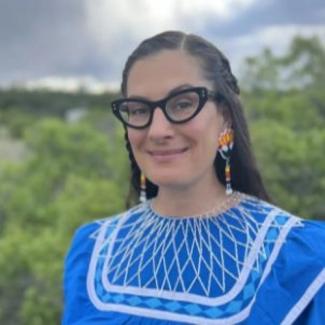
Halito akana (Hello friends),
I am writing, it is late Spring here on Turtle Island. My family and I just planted Chikashsha tanchi homma (Chickasaw red corn) under a new moon. loom corn, passed down for many generations, was carried by my Chickasaw ancestors on the Trail of Tears when they were removed from our homelands. We will soon plant beans, squash, and other crops alongside the corn. Some of our seeds were rematriated by the Choc- taw Nation of Oklahoma’s Growing Hope Program, allowing us to revitalize our traditional foods, a foundational component of our heritage and culture.
Rematriation encompasses the many ways Indigenous Peoples are reclaiming our homelands, languages, lifeways, knowledge systems, cultural practices, sacred objects, and ancestral remains. As Crystal Cavalier-Keck (Occaneechi-Saponi) beautifully states, rematriation “is a sacred process of restoring Indigenous relationships to land, water, language, and spiritual responsibility. Where colonization sought to sever these relationships, rematriation centers Indigenous women, matrilineal knowledge systems, and cultural continuity to heal what was disrupted, displaced, or violently stolen.” This CSQ highlights examples of those working tirelessly to reverse colonization’s negative impacts and return home that which belongs to us for past, present, and future generations.
In 1990, the U.S. Native American Graves Protection and Repatriation Act (NAGPRA) was passed. It protects and provides for the return of Native American human remains along with funerary, sacred, and cultural patrimony objects to their respective Native Nations. Since then, 126,299 human remains and more than 1.86 million objects have been returned. Yet, only 31% of museums subject to NAGPRA have returned the human remains under their control, and museums, libraries, private collectors, and other institutions worldwide continue to hold millions of stolen items and ancestral remains that belong to our communities. The Catholic Church is one of the largest landholders globally, with thousands of sacred objects in its collections. The Church must address the dark legacy of residential schools, return our ancestors home from a multitude of unmarked graves, and give back land and objects stolen from Indigenous Peoples. We call on the new pope, Leo XIV, to address these dire needs and advance reconciliation processes.
Land Back movements are a form of rematriation and include governments, faith-based organizations, institutions returning land to Indigenous Peoples, and purchases by Indigenous communities. As communities and Indigenous-led organizations continue to actively reclaim territories through advocacy, purchasing land and items, and reviving languages and cultural practices such as tattooing and heirloom seed-keeping, we are proud to support this work through grantmaking, capacity building, advocacy, and storytelling.
However, this crucial work is under threat. Since taking office, President Donald Trump has signed several executive orders and directed actions that have disproportionately negative impacts on Indigenous people. We stand in solidarity with Indigenous communities and remain committed to advocating for their rights, sovereignty, and well being. We actively monitor these developments and work alongside our partners to challenge policies in the U.S. and other places that threaten Indigenous lands, cultures, and self-determination.
Your support helps Indigenous Peoples safeguard knowledge systems, languages, and lifeways for future generations and allows us to amplify Indigenous voices in leading the way to healing and securing a sustainable future for Mother Earth and all of us. Please give generously at www.cs.org/donate.
Hטchi yakoke li hoke (I thank you all so much),
Aimee Roberson (Choctaw and Chickasaw)
Executive Director
